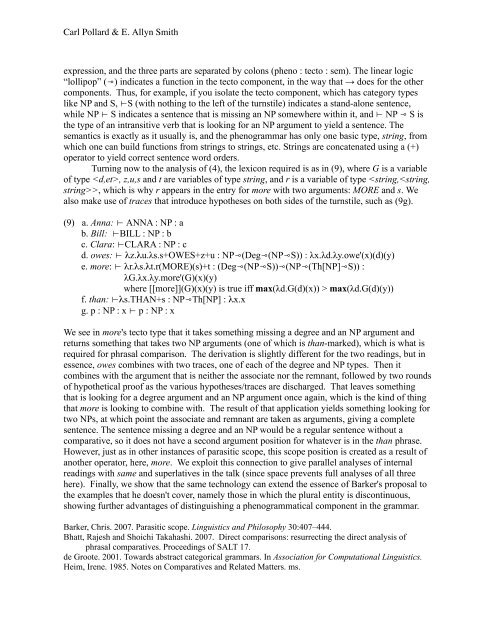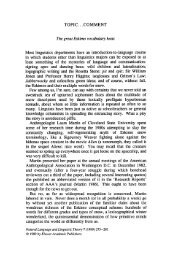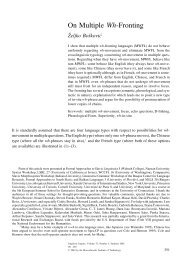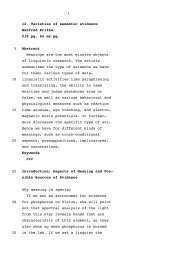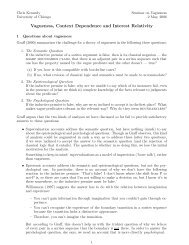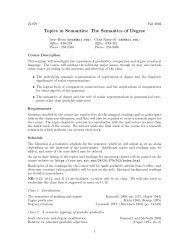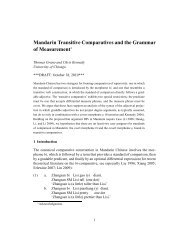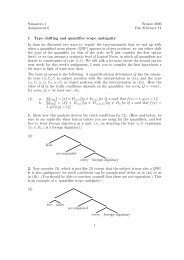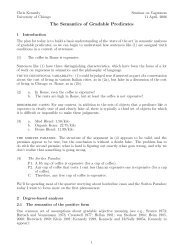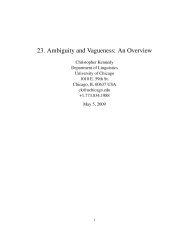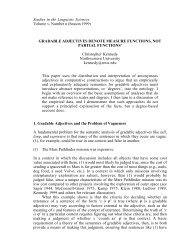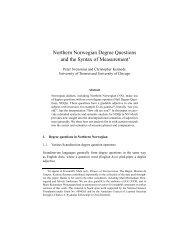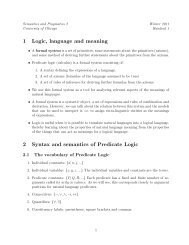On the natural history of negative polarity items - Syntax, Semantics ...
On the natural history of negative polarity items - Syntax, Semantics ...
On the natural history of negative polarity items - Syntax, Semantics ...
Create successful ePaper yourself
Turn your PDF publications into a flip-book with our unique Google optimized e-Paper software.
Carl Pollard & E. Allyn Smith<br />
expression, and <strong>the</strong> three parts are separated by colons (pheno : tecto : sem). The linear logic<br />
“lollipop” ( " ) indicates a function in <strong>the</strong> tecto component, in <strong>the</strong> way that " does for <strong>the</strong> o<strong>the</strong>r<br />
components. Thus, for example, if you isolate <strong>the</strong> tecto component, which has category types<br />
like NP and S, ! S (with nothing to <strong>the</strong> left <strong>of</strong> <strong>the</strong> turnstile) indicates a stand-alone sentence,<br />
while NP ! S indicates a sentence that is missing an NP somewhere within it, and ! NP " S is<br />
<strong>the</strong> type <strong>of</strong> an intransitive verb that is looking for an NP argument to yield a sentence. The<br />
semantics is exactly as it usually is, and <strong>the</strong> phenogrammar has only one basic type, string, from<br />
which one can build functions from strings to strings, etc. Strings are concatenated using a (+)<br />
operator to yield correct sentence word orders.<br />
Turning now to <strong>the</strong> analysis <strong>of</strong> (4), <strong>the</strong> lexicon required is as in (9), where G is a variable<br />
<strong>of</strong> type , z,u,s and t are variables <strong>of</strong> type string, and r is a variable <strong>of</strong> type , which is why r appears in <strong>the</strong> entry for more with two arguments: MORE and s. We<br />
also make use <strong>of</strong> traces that introduce hypo<strong>the</strong>ses on both sides <strong>of</strong> <strong>the</strong> turnstile, such as (9g).<br />
(9) a. Anna: ! ANNA : NP : a<br />
b. Bill: ! BILL : NP : b<br />
c. Clara: ! CLARA : NP : c<br />
d. owes: ! !z.!u.!s.s+OWES+z+u : NP " (Deg " (NP" S)) : !x.!d.!y.owe'(x)(d)(y)<br />
e. more: ! !r.!s.!t.r(MORE)(s)+t : (Deg " ( NP"S)) " (NP " (Th[NP] " S)) :<br />
!G.!x.!y.more'(G)(x)(y)<br />
where [[more]](G)(x)(y) is true iff max(!d.G(d)(x)) > max(!d.G(d)(y))<br />
f. than: !!s.THAN+s : NP" Th[NP] : !x.x<br />
g. p : NP : x ! p : NP : x<br />
We see in more's tecto type that it takes something missing a degree and an NP argument and<br />
returns something that takes two NP arguments (one <strong>of</strong> which is than-marked), which is what is<br />
required for phrasal comparison. The derivation is slightly different for <strong>the</strong> two readings, but in<br />
essence, owes combines with two traces, one <strong>of</strong> each <strong>of</strong> <strong>the</strong> degree and NP types. Then it<br />
combines with <strong>the</strong> argument that is nei<strong>the</strong>r <strong>the</strong> associate nor <strong>the</strong> remnant, followed by two rounds<br />
<strong>of</strong> hypo<strong>the</strong>tical pro<strong>of</strong> as <strong>the</strong> various hypo<strong>the</strong>ses/traces are discharged. That leaves something<br />
that is looking for a degree argument and an NP argument once again, which is <strong>the</strong> kind <strong>of</strong> thing<br />
that more is looking to combine with. The result <strong>of</strong> that application yields something looking for<br />
two NPs, at which point <strong>the</strong> associate and remnant are taken as arguments, giving a complete<br />
sentence. The sentence missing a degree and an NP would be a regular sentence without a<br />
comparative, so it does not have a second argument position for whatever is in <strong>the</strong> than phrase.<br />
However, just as in o<strong>the</strong>r instances <strong>of</strong> parasitic scope, this scope position is created as a result <strong>of</strong><br />
ano<strong>the</strong>r operator, here, more. We exploit this connection to give parallel analyses <strong>of</strong> internal<br />
readings with same and superlatives in <strong>the</strong> talk (since space prevents full analyses <strong>of</strong> all three<br />
here). Finally, we show that <strong>the</strong> same technology can extend <strong>the</strong> essence <strong>of</strong> Barker's proposal to<br />
<strong>the</strong> examples that he doesn't cover, namely those in which <strong>the</strong> plural entity is discontinuous,<br />
showing fur<strong>the</strong>r advantages <strong>of</strong> distinguishing a phenogrammatical component in <strong>the</strong> grammar.<br />
Barker, Chris. 2007. Parasitic scope. Linguistics and Philosophy 30:407–444.<br />
Bhatt, Rajesh and Shoichi Takahashi. 2007. Direct comparisons: resurrecting <strong>the</strong> direct analysis <strong>of</strong><br />
phrasal comparatives. Proceedings <strong>of</strong> SALT 17.<br />
de Groote. 2001. Towards abstract categorical grammars. In Association for Computational Linguistics.<br />
Heim, Irene. 1985. Notes on Comparatives and Related Matters. ms.


